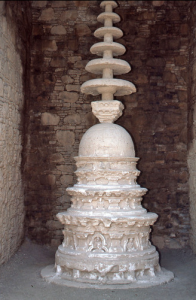

Perhaps the most directly connected to the physical exhibition, this essay discusses the context behind Gandharan reliefs by presenting a clear painting of stupa and monastery building during the time period. With a reinforcement of Narratives and Architectural Contexts, the essay begins by emphasizing to the reader that “many of the works in [the] catalogue and the accompanying exhibit were originally part of an architectural context, and many forms can only be understood on the basis of their original use.”1With this in mind, particular overarching motifs, common designs for such features as garland hangers, and specific locations of reliefs can be explored only by the comparison of many different objects.1As an extension of the physical exhibit, the inclusion of pictures of small stupa models and archeological sites allows a more in depth view of stupa building which may be carried over into the catalogue or physical exhibit. As with other sections, this essay serves as a companion to the physical exhibit, but also allows a more detail oriented viewing due to its nature as a complied paper rather than an open room. This rigidity, however, compliments the larger exhibition rather than opposing it by offering a different perspective on similar materials.
- Ed. Proser, Adriana. The Buddhist Heritage of Pakistan: Art of Gandhara